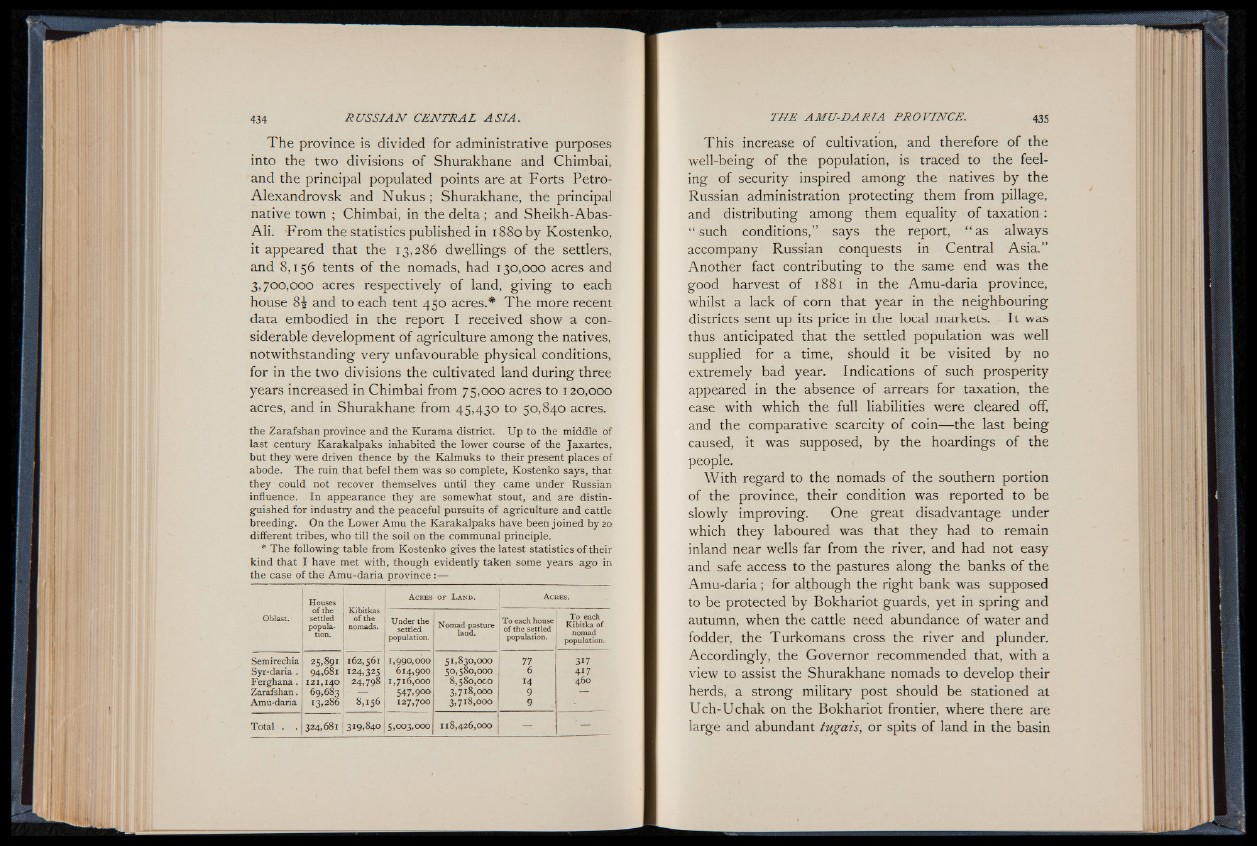
The province is divided for administrative purposes
into the two divisions of Shurakhane and Chimbai,
and the principal populated points are at Forts Petro-
Alexandrovsk and Nukus ; Shurakhane, the principal
native town ; Chimbai, in the delta ; and Sheikh-Abas-
Ali. From the statistics published in 1880 by Kostenko,
it appeared that the 13,286 dwellings of the settlers,
and 8,156 tents of the nomads, had 130,000 acres and
3,700,000 acres respectively of land, giving to each
house 82 and to each tent 450 acres.* The more recent
data embodied in the report I received show a considerable
development of agriculture among the natives,
notwithstanding very unfavourable physical conditions,
for in the two divisions the cultivated land during three
years increased in Chimbai from 75,000 acres to 120,000
acres, and in Shurakhane from 45,430 to 50,840 acres.
the Zarafshan province and the Kurama district. Up to the middle of
last century Karakalpaks inhabited the lower course of the Jaxartes,
but they were driven thence by the Kalmuks to their present places of
abode. The ruin that befel them was so complete, Kostenko says, that
they could not recover themselves until they came under Russian
influence. In appearance they are somewhat stout, and are distinguished
for industry and the peaceful pursuits of agriculture and cattle
breeding. On the Lower Amu the Karakalpaks have been joined by 20
different tribes, who till the soil on the communal principle.
* The following table from Kostenko gives the latest statistics of their
kind that I have met with, though evidently taken some years ago in
the case of the Amu-daria province :— :
Houses
Kibitkas
o f the
nomads.
A c r e s o f L a n d . A c r e s .
Oblast.
o f the
settled
population.
Under the
settled
population.
Nomad pasture
land.
To each house
o f the settled
population.
To each
Kibitka of
nomad
population.
Semirechia 25,891 162,561 1,990,000 51,830,000 77 3U
Syr-daria . 94,681 124,325 614,900 50,580,000 6 417
Ferghana. 121,140 24,798 1,716,000 8,580,000 14 460
Zarafshan. 69,683 ' — 547.900 3,718,000 9 —
Amu-daria 13,286 8,156 127,700 3,718,000 9
Total . . 324,681
5P0
0 -£>■O
5,003,000 118,426,000 1
This increase of cultivation, and therefore of the
well-being of the population, is traced to the feeling
of security inspired among the natives by the
Russian administration protecting them from pillage,
and distributing among them equality of taxation:
“ such conditions,” says the report, “ as always
accompany Russian conquests in Central Asia.”
Another fact contributing to the same end was the
good harvest of 1881 in the Amu-daria province,
whilst a lack of corn that year in the neighbouring
districts sent up its price in the local markets. It was
thus anticipated that the settled population was well
supplied for a time, should it be visited by no
extremely bad year. Indications of such prosperity
appeared in the absence of arrears for taxation, the
ease with which the full liabilities were cleared off,
and the comparative scarcity of coin— the last being
caused, it was supposed, by the hoardings of the
people.
With regard to the nomads of the southern portion
of the province, their condition was reported to be
slowly improving. One great disadvantage under
which they laboured was that they had to remain
inland near wells far from the river, and had not easy
and safe access to the pastures along the banks of the
Amu-daria ; for although the right bank was supposed
to be protected by Bokhariot guards, yet in spring and
autumn, when the cattle need abundance of water and
fodder, the Turkomans cross the river and plunder.
Accordingly, the Governor recommended that, with a
view to assist the Shurakhane nomads to develop their
herds, a strong military post should be stationed at
Uch-Uchak on the Bokhariot frontier, where there are
large and abundant tugáis, or spits of land in the basin